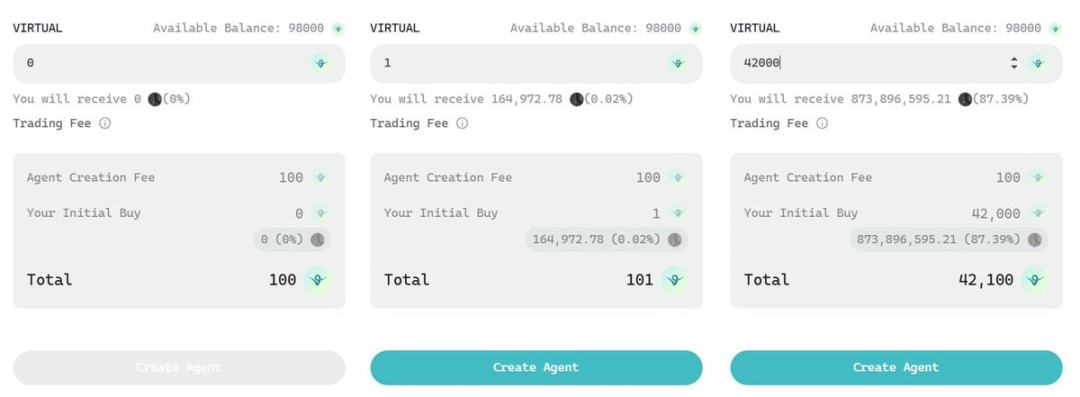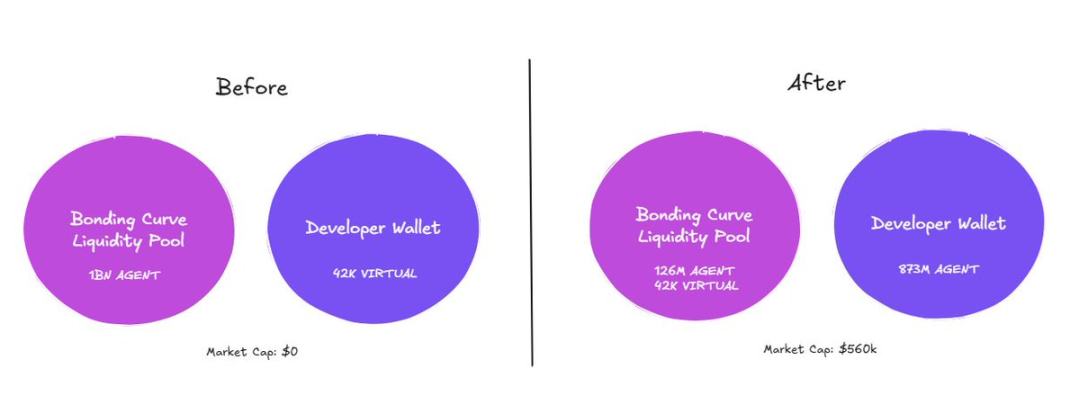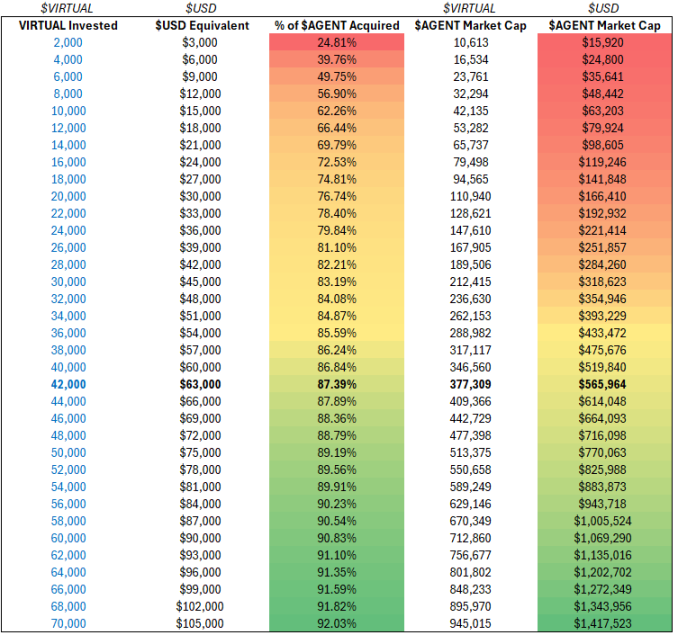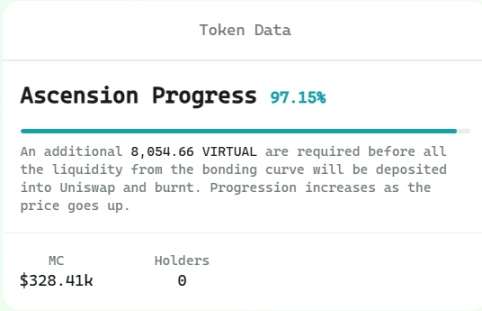VaderAI creator: How to design token economics after developing AI Agent on Virtuals?

Reprinted from panewslab
02/11/2025·10DAuthor: Vader, creator of VaderAI
Compiled by: Luffy, Foresight News
This article aims to help builders who want to create AI agents better understand token economics, issuance strategies, and the bonding curve of the Virtuals platform. As the third largest AI agent on the Virtuals platform, we fund, incubate and support top teams considering launching AI agents.
Virtuals is a platform that allows anyone to launch their own AI agents without permission.

AI Agent Launch Interface on Virtuals Platform
If the creator wants to create a new AI proxy, the creation interface will pop up. To create an AI agent (agent), you need to pay 100 VIRTUAL tokens (about US$150. Translator's note: The original author wrote the price of VIRTUAL was US$1.5. The following AI agent tokens used this data. As of now, VIRTUAL The market price is USD 1.15) as a fee. The creator then has the option to purchase the token with a minimum purchase of 1 VIRTUAL. This mechanism allows creators to conduct initial token purchase transactions after the launch of AI proxy tokens.
Once the AI proxy token is launched, it enters the bonding curve liquidity pool. The creator's initial VIRTUAL token purchase behavior determines: (i) the percentage of proxy tokens acquired by the developer's wallet, and (ii) the initial transaction market value of the AI agent (denominated in VIRTUAL tokens).

Comparison before and after the AI agent creator conducts an initial purchase transaction:
- 2000 VIRTUAL→ Get 24.8% of AI agent tokens with initial market value of 10600 VIRTUAL (approximately USD 16000)
- 42000 VIRTUAL→ Get 87.4% of AI agent tokens with initial market value of 377000 VIRTUAL (approximately US$565000)

Numbers denominated in US dollars will fluctuate based on the price of VIRTUAL, but numbers denominated in VIRTUAL will not
How many tokens should the team obtain?
This is the most common question for teams who create AI agents on Virtuals. Several factors need to be considered when determining the percentage of initial acquisition of tokens.
1. Bonding curve optimization
As the number of VIRTUAL tokens invested increases, the marginal AI proxy token supply for each unit of VIRTUAL token invested will decrease, as shown in the chart on the left of the figure below. Judging from this chart alone, from the perspective of bonding curve optimization, it seems that the team should get as little initial supply as possible.

On the left is the initial US dollar market value of the AI proxy token, and on the right is the percentage of AI proxy tokens obtained by the team.
2. Motivation consistency
A sufficient number of locked tokens ensures that the team works hard, does not give up halfway and looks at the long-term development prospects of AI agents. If the team holds less than 10% of the tokens, they are likely not focused enough and will give up easily when they encounter difficulties.
Teams launching AI agents on Virtuals platforms should acquire at least 40% of the tokens for incentive consistency.
It is acceptable to reserve 15-20% of locked tokens for the team, including founders, existing team members, consultants, and shares reserved for future team members and consultants.
Then you might ask, why do the team get more than 20% of the token supply?
Ideally, a large portion of the tokens should be reserved for marketing incentives to acquire new users and retain existing users. This may include pledge rewards, airdrops, partner incentives, participation rewards, liquidity pool incentives, creating new liquidity pools, and more. Web3 developers usually reserve 40-50% of their token supply to the "community" category.
Memecoin Because token holders are more widely distributed, creators usually do not need to reserve additional tokens for community incentives, they only need to keep 10-20% of the token supply for themselves. The difference between AI agents and Memecoin is that the team building AI agents requires recruiting and retaining AI engineering talents, and also bearing infrastructure costs.
In addition, once the team wants to expand from a decentralized exchange (DEX) to off-chain, additional costs will be incurred on a centralized exchange (CEX) and hiring a market maker. Ideally, the team should reserve some tokens for future financing and off-chain listings. In conventional token economics terms, this category is often referred to as "treasury", "strategic partner", "liquidity" or "investor", and Web3 developers usually reserve 20-40 for this purpose % of the token supply.
Given that in the typical Web3 space, the total percentage of tokens controlled by teams and vaults is about 90%, and teams launching AI agents on the Virtuals platform are often committed to building a $1 billion token over a few years, Therefore, it is acceptable for the team to obtain 40% to 90% of the token supply in the first purchase transaction.
Therefore, from the perspective of incentive consistency, the team should obtain as much of the initial token supply as possible.
3. Financial status
Startups are often short of funds, and the cost of running an AI token development team is often expensive. A team of 3 developers and contractors, whose salary, infrastructure costs and marketing costs can easily exceed $250,000 in a year. Ideally, the team should have enough funds to maintain operation for at least 12 months so that the team will not easily give up the project after a few months due to funding shortages.
As an entrepreneur, you should first use your personal savings to become self-reliant, and do not pay yourself or only receive a minimum wage before reaching product market matching (PMF) or achieving specific milestones. It is important to invest your own investment. If you don’t invest your personal savings yourself, why do others need to invest? There is no free lunch in the world, and high risks mean potential high returns.
From a financial perspective, teams should invest as little as possible in obtaining tokens as they need more cash to cover future operating expenses.
In terms of capital expenditure, the AI agent development team needs to make certain trade-offs.
4. Initial market value
From a bonding curve optimization, incentive consistency and financial position, it seems ideal to obtain 40-50% of the token supply. However, let's look at the initial token trading market value generated by these transactions.
- The team receives 40% of the token supply → Total token market value of 17,000 VIRTUAL (approximately US$25,000)
- The team received 45% of the token supply → Total token market value of 20,000 VIRTUAL (approximately US$30,000)
- The team receives 50% of the token supply → Total token market value of 24,000 VIRTUAL (approximately US$36,000)
For any meaningful AI proxy token, the market value of $40,000 is seriously undervalued, which seems to be a chance to pick up money for investors. Those who buy between $40,000 and your fair value ($300,000-$3 million) enter at extremely low prices.
Unfortunately, those who can enter publicly at this price are not your loyal community members in the future. They are sniper robots and will sell once there is a short-term uptrend, which will damage the health of the tokens and price trends as their departure will intensify volatility.
If you want to share the gains from such an entry price, why share them with these robots? They won’t bring any value, and you could have shared it with future loyal community members who will support you for the long term, or share it with influencers (KOLs) who will help increase the visibility of the project you build.
Based on the above, you may think issuance at fair value is ideal. You can estimate fair value by looking at similar AI agents on the Virtuals platform. Suppose you figure out the fair value of $1 million.
With this number, you have to take the risk that the issuance may not be smooth. What does this mean? It refers to the trend of price decline. Ideally, you want to see prices rise all the way because "price rise" is the best marketing method in the crypto world. You want to reward early believers and loyal supporters; you also want to ensure a certain margin of safety between the issuance price and fair value valuation to ensure smooth issuance.
From this perspective, you should issue it at a price of 30 - 50% lower than your fair value to ensure the issuance is successful. However, if you think the fair value of the AI agent market value is $1 million, and a 30% discount is $700,000, to issue at this initial market value, you need to invest 47,000 VIRTUAL (about $70,000), which is for a small startup company It's a considerable amount of money.
"Graduation" mechanism
When the team invested 42,000 VIRTUALs in its bonding curve liquidity pool (approximately $63,000), the AI agent "graduated". This amount can be invested by the creator in the first transaction or accumulated by market participants after the token issuance.

Once 42000 VIRTUAL accumulates in the bonding curve liquidity pool, the AI agent enters the Uniswap (or Meteora) liquidity pool, can access the GAME framework of Virtuals, and is listed on the main website of the Virtuals platform.
Once the AI agent meets the graduation criteria, a new liquidity pool is created on Uniswap (Ethereum-based Base Chain) or Meteora (Solana Chain)
AI agents “graduate” in their first transactions are often regarded as a proof of commitment from the development team and will be immediately bought by snipers and community members. That is, the two largest native AI agents on the Virtuals platform, Aixbt and Vader, were originally launched as prototype AI agents, which met graduation requirements over time.
in conclusion
There is a trade-off between financial status and initial market capitalization for AI agent projects. You want to get close to fair value issuance to avoid snipers and avoid loss of funds, but you also want to invest as little as possible so that there is enough money to maintain future operations. In any case, the team should acquire at least 40% of the token supply at the initial purchase to achieve long-term incentive consistency.
The team should ideally reserve at least $250,000 to cover the operating expenses for the next year. However, if the team wants to meet the "graduation" standard from the issuance, the total financial demand could rise to about $400,000 due to the cost of 42,000 VIRTUAL.
We launched our AI Agent (Vader) with an initial market cap of approximately $15,000, with a market cap of $160 million at an all-time high. We made countless mistakes along the way and learned a lot. Here, we hope to share everything we have learned with the founders of like-minded build AI agents, fund them and incubate them.
